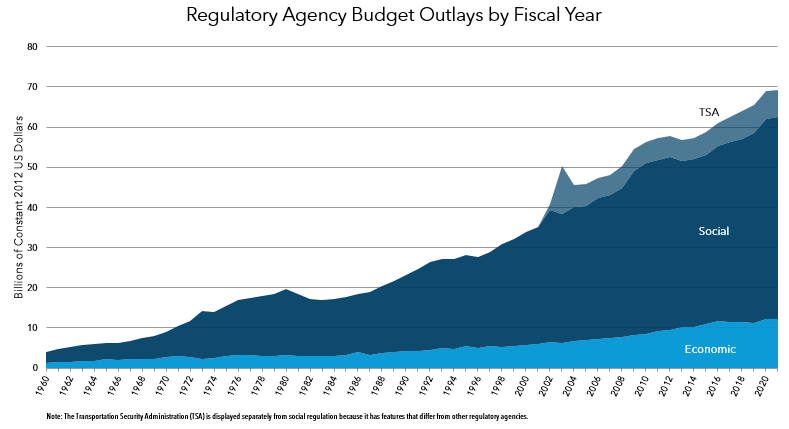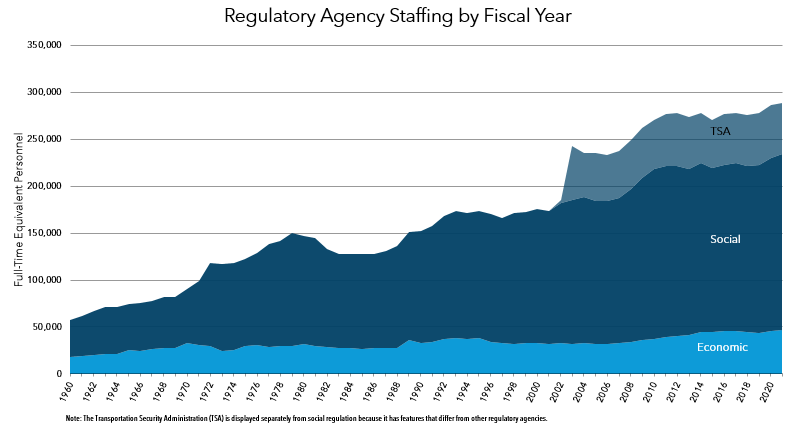Interview with co-author Mark Febrizio
About the Regulators' Budget Report
This report is a joint effort of the Weidenbaum Center on the Economy, Government, and Public Policy at Washington University in St. Louis and the George Washington University Regulatory Studies Center in Washington, DC. This report is one in a series designed to enhance the understanding of the impact of federal regulation on society and does not represent an official position of either the George Washington University or Washington University in St. Louis.
The Weidenbaum Center is a research institute at Washington University in St. Louis that supports scientific research in the fields of public policy, economics, political science, and sociology. The Center funds faculty research, provides administrative support for research activities, and sponsors a wide range of public affairs programs. In doing so, the Center serves as a bridge between scholars, policymakers, and the general public. Through unbiased empirical research and events, the Center addresses many of the pressing public policy issues facing America and the world today.
The George Washington University Regulatory Studies Center raises awareness of regulations’ effects to improve regulatory policy through research, education, and outreach. It is a leading source for applied scholarship on regulatory issues, and a training ground for current and future policy officials who want to understand the effects of regulation and ensure that regulatory policies serve the public interest.
Summary
The president’s FY 2021 budget would slightly increase overall spending on regulatory agencies over estimated 2020 levels. It requests $79.8 billion in regulatory outlays, compared to estimated outlays of $77.8 billion in 2020. In real (inflation-adjusted) terms, this would mean a 0.3 percent increase in spending. The FY 2020 regulators’ budget is 5.5 percent higher than in 2019. The number of regulators would rise from 286,647 in 2020 to 288,409 in 2021 (a 0.6 percent increase).
While relatively flat, these topline figures obscure large proposed changes in some regulatory agencies. Consistent with previous budget requests from the Trump administration, agencies involved in homeland security functions are scheduled to receive significant increases in both funds and staff. Under the president’s proposal, regulatory activities in the Department of Homeland Security (DHS) would receive a 3.1 percent real increase in resources and a 1.6 percent increase in staff in 2021, building on even larger increases the previous year. The requests for Immigration and Customs Enforcement (ICE) and the U.S. Coast Guard are driving these increases in homeland security spending and personnel.
Proposed reductions for agencies with other regulatory functions largely offset increases, keeping regulatory spending relatively flat. While agencies focused on consumer safety and health are set to receive 2.6 percent more in constant dollars, funding for the three other main categories of social regulation—transportation, workplace, and environment and energy—would decline in real terms. Consistent with another trend in recent budget requests, agencies involved in environmental and energy regulation would bear the biggest cuts—a proposed reduction of 13.1 percent below 2020 spending levels in real terms and 10.3 percent below 2020 staffing.
Overall, agencies conducting economic regulation—categorized as finance and banking, industry-specific regulation, and general business—would receive a 0.1 percent increase in real resources. The overall increase stems from 2.5 percent more funding proposed for general business, the largest economic regulation category, while spending for the other two categories would fall under the FY 2021 request.
Regulatory Agency Budget Outlays
The president’s FY 2021 budget requests $79.8 billion in regulatory outlays, compared to estimated outlays of $77.8 billion in 2020 (a 0.3 percent increase in real terms). The FY 2020 regulators’ budget is 5.5 percent higher than in 2019.



